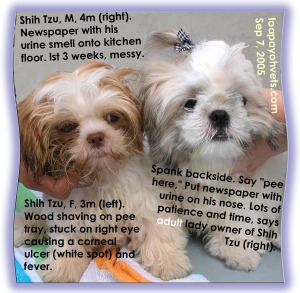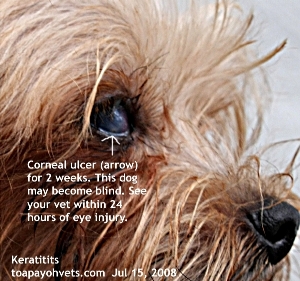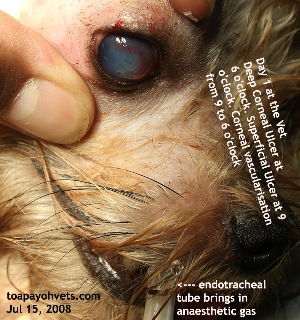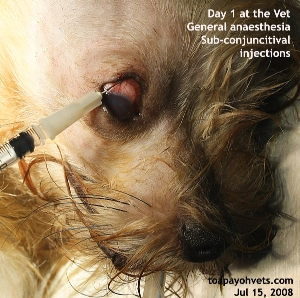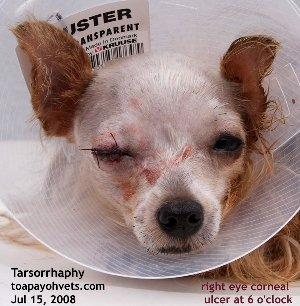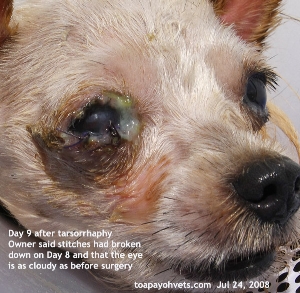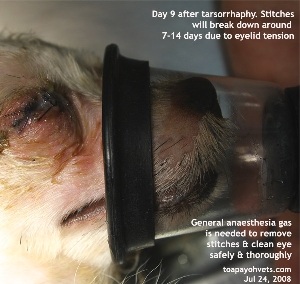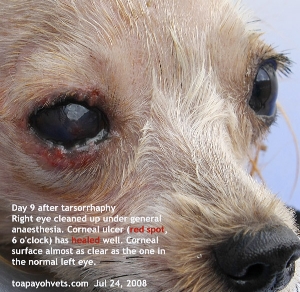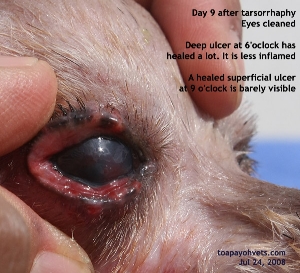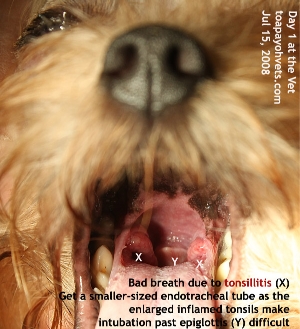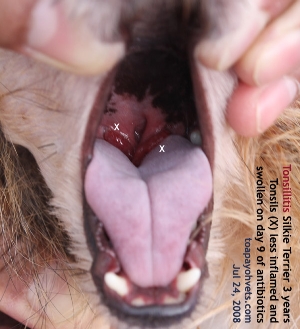Dr Sing Kong Yuen, BVMS (Glasgow), MRCVS
Case written in a blog: 24 July 2008
Case updated: 06 June, 2009
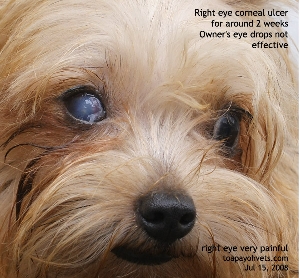 "My
dog's eye is still as bad as before you did your operation," the
young lady with the big brown eyes matching her Silkie Terrier's
phoned me on the 9th day after tarsorrhaphy - a surgical
procedure to stitch up the upper and lower eyelids.
"My
dog's eye is still as bad as before you did your operation," the
young lady with the big brown eyes matching her Silkie Terrier's
phoned me on the 9th day after tarsorrhaphy - a surgical
procedure to stitch up the upper and lower eyelids."The eyelids had opened up. Stitches hung from the lower eyelid. I can see that the eye has not improved at all. Does my dog need the eyelids stitched together again? "
"The stitches were used to
protect the cornea from drying up so that the ulcer could heal.
They hold the eyelids for 7-10 days. Due to the
eyelid movement, the stitches will break but the dog's eye
should be much better," I was surprised that the young lady with
clear brown eyes had been disappointed. In my
experience, tarsorrhaphy is very effective in healing the
superficial and many deep
corneal ulcers.
"You will need to bring the dog in for examination as it is hard
to diagnose over the phone." Many owners expect one treatment
cure all - otherwise the veterinarian is not competent. But this
is not always the case especially in eye and skin diseases.
In addition, this pet shop owner insisted on taking the dog
home immediately after surgery to save on costs.
Yet she did not know or had
time to nurse the dog's eyes. Just putting some eye-drops
would not be sufficient nursing. The eyes needed to be cleaned
twice a day, checked and for some owners, this was difficult
to do. At home, the dog just would not be so submissive. He
will turn his head and move here and there. Some dog owners
just could not do any nursing.
The owner brought the dog to the surgery today. My veterinary
assistant took out the suture removal forceps all ready to take
out the 2 sutures now hanging loose from the lower eyelid.
"This dog needs to be
under general anaesthesia," I said to the dog owner and Mr
Saw, my veterinary assistant. "If we take out the
sutures without anaesthesia, the dog may move. The forceps may puncture
the eye cornea. The eyeball collapses and we will have a blind dog!"
I asked the young lady to come back in the afternoon as she has
her pet shop business to attend to. The dog's cornea was around 80%
clear compared to 90% cloudy 9 days ago after cleaning
the debris but the initial sight looked horrible to the fair
pet shop owner, a lady in her twenties.
The dog should recover
with 95% clear cornea and a 5% white scar. As the injury existed
for around 2 weeks, you can see the ring of blood vessels on the
cornea (corneal vascularisation) 9 days ago. At day 9
after tarsorrhaphy, the vascular ring had disappeared indicating
that inflammation had subsided after veterinary treatment and
tarsorrhaphy to protect the cornea from irritation, inflammation
and drying up. This healing would not occur if the eyelids
had not been stitched up. Although the stitches were said to
break 3 days after stitching, there was still sufficient time
for corneal healing in this case. There were no more
complaints from the owner after this visit.
This dog had a horrible bad breath on the first day. His teeth
were quite clean. The smell came for much enlarged tonsils which
were around 1 cm x 0.5 cm in size. I saw the tonsils during
intubation to put the dog under general anesthesia. As for
today, he had no bad breath and must be feeling much better. As
to why he had such big tonsils, it would be due to daily
infections from the bacteria from the tartar and plaques inside
the mouth.
This dog's bad breath will return after some time. As the lady
owner's nose may be insensitive to the smell of bad breath due
to daily exposure, it may be important for the veterinarian to
at least, inform the lady owner that dental scaling of her
3-year-old Silkie Terrier needs to be done to get rid of the
foul-breath forming bacteria. In this case, I have not informed
the lady whose big brown eyes match exactly the colour of her
constant companion.
I note that many Singapore dog owners of the baby boomer
generation are not interested in the dental health of their
dogs. They just accept teeth falling out with the years and live
with the bad breath and let the dog suffer tooth ache. Maybe the
internet generation can be educated and be more caring. Some
owners may be ignorant but for this pet shop owner, it would be
the dollars and cents that mattered.
 TOA
PAYOH VETS
TOA
PAYOH VETS